Since 1980, Klein-Karoo Seed Production has gained international recognition for its multiplication of different types of vegetable seeds. Its forte is the edible members of the Allium family: onions, bunching onions, leeks as well as carrot seeds.
The Klein-Karoo’s climate, a Mediterranean-type climate with an average of 180 to 220mm per year of winter rainfall, is perfect for seed multiplication.
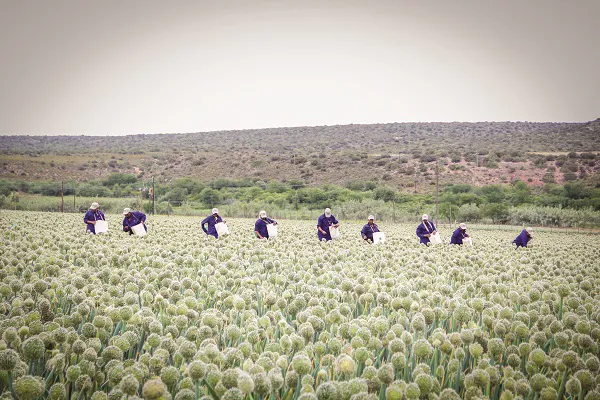 The onion pollination period, now nearing its end, is a nervous time (photos by Ilse Jordan)
The onion pollination period, now nearing its end, is a nervous time (photos by Ilse Jordan)
Resumption of international visits
This time of the year, with onions nearing the end of the flowering and pollination season, is a crucial period for international clients to visit and view their seed production fields for much needed yield estimates.
The onion pollination period – three weeks that crown a process that had started 23 to 28 months before with the initial contract – is a nervous time. The Klein-Karoo has had good rain recently after years of drought, but it has come with some hail damage.
“The last couple of months almost returned to normal, and we had a lot of visits from clients. Despite the new Covid variant and the border decision we still had a couple of Dutch firms who decided to complete their visits,” says David Malan, managing director of Klein-Karoo Seed Production, a company held by the Klein Karoo Group and based in Oudtshoorn, Western Cape.
Their clients hail from across the world, including Japan, South Korea, China, Australia, Brazil, Turkey, Iran, Libya, Tanzania, Kenya, Uganda, Holland, France, Italy and North America.
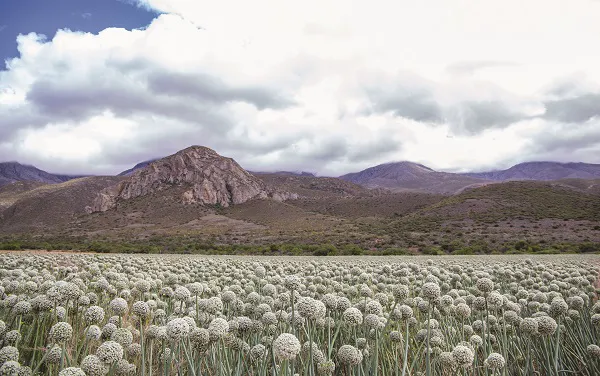 The Klein-Karoo's low rainfall and rugged topography are ideal for vegetable seed production
The Klein-Karoo's low rainfall and rugged topography are ideal for vegetable seed production
“The great thing about vegetable seed production is that most places that produce good wine also produce good vegetable seed,” David smiles.
The leek and the carrot flowering season starts towards the end of onion pollination.
“Our seed producers are very experienced and it’s a very specialized form of production. We would have no business without our seed farmers.” He adds: “We value them tremendously.”
He emphasises that there is currently no genetic manipulation of vegetable seed and new varieties are the result of genetic selection and standard breeding techniques.
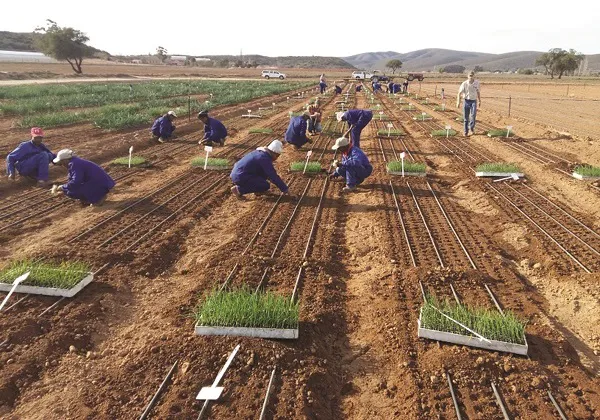
Red onions: “Onion market is changing and adapting to more modern tastes”
New bunching onion seed is mainly produced over a period of 12 to 14 months for clients in the Far East.
For Mexican clients, Klein-Karoo Seed Production grows a cross between A. fistulosum (bunching onions) and A. cepa (bulb onions), a plant with a very strong root system, and suitable for very difficult growing conditions.
There is talk of garlic seed becoming available from breeders in Europe but at the moment they do not multiply garlic.
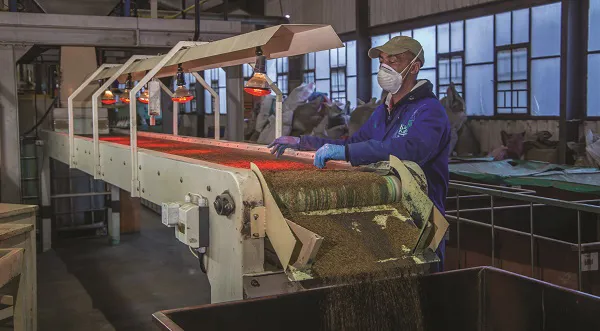 Cleaning onion seed
Cleaning onion seed
“We used to grow roughly 70% brown onions, 15% white and 15% red, more or less in that order, but the onion market is changing and adapting to more modern tastes. Housewives have noticed the value of red onions for garnishing and they like its pungent taste, so consequently the use of red onions has increased significantly both internationally and in South Africa,” he says.
“Increasingly our clients are requesting that we multiply more red onions and it’s a trend that will continue in future, we believe.”
Short day onions drive growing worldwide demand
South African onion seed production is limited by its latitude (23° to 33° South) to tropical onions, short day onions and intermediate day onions. Areas like North America, South America and Northern Europe like France and Denmark are able to grow longer day onions.
The zone lying between 30° South to 30° North is suited to short day, or tropical, onions and it is a part of the world experiencing fast population growth and rising onion consumption, which is very good news for the onion seed market in future, he points out.
“We can see there’s growing diversification in the diets of people in the developing world, who are eating a wider range of vegetables, in Africa as well as other developing countries. The culinary influence of Chinese, Koreans and Indians in Africa is also stimulating demand for onions on the continent.”
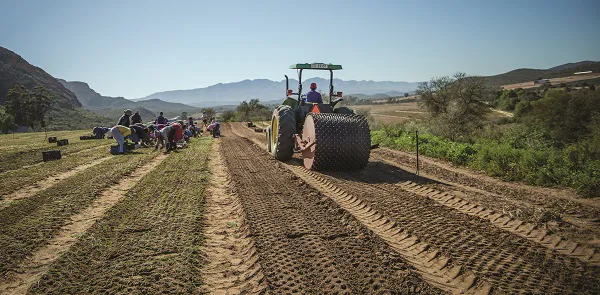
He continues: “It’s incredible how the use of vegetables and specifically onions increased during the Covid period. An enormous lot of home cooking was done and there was a renewed appreciation of the importance of onions as a flavourant in cooking. Many people also took up home gardening and changed to more healthy eating."
"Sales of vegetable seed generally increased during Covid, lettuce or tomatoes maybe to a lesser extent (those were before Covid predominantly used in catering and the hospitality industry) but more the everyday vegetables like cabbage, onions and pumpkins.”
Nothing happens without bees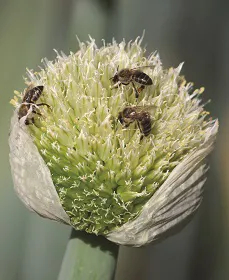 David remarks that humans’ dependence on honeybees for our food crop has increased, and nowhere is this more true than in the business of multiplying seed. Apart from the climate, bee activity is their other major risk factor.
David remarks that humans’ dependence on honeybees for our food crop has increased, and nowhere is this more true than in the business of multiplying seed. Apart from the climate, bee activity is their other major risk factor.
“On onions we come on 18 months with our product by the time that it starts to flower and if the bees aren’t working during the crucial three to four weeks of flowering it can nullify a whole harvest,” he observes.
Onion flowers aren’t exactly bees’ favourite flowers and when there’s an abundance of wildflowers after good rain, it can turn their heads to work away from the onions. Poor weather conditions during flowering can also adversely affect the pollination. Open varieties receive 8 to 10 hives per hectare and on F1 fields there are 12 to 15 hives per hectare, depending on the amount of food or flowers in the field.
Multiplying seed true to type and matching the parent lines is the crux of their work, meaning that crosspollination has to be avoided at all costs. The mountainous topography of the Klein-Karoo helps in that regard, creating numerous valleys surrounded by rugged peaks which honeybees won’t cross.
“Red onions have very dominant pollen so they’re grown at least 5,000m from white or yellow onion blocks. We keep very strict isolation rules,” he points out. “Even between different cultivars of the same type and colour of onion we maintain a distance of at least 2,000m, although many clients even require a 3,000m distance between blocks to prevent crosspollination.”
“It’s a very intensive industry with high rewards”
The process starts in March (late summer in South Africa) when the onion parent or stock seeds that Klein Karoo Seed Production received from their clients are sown in seed beds or in seedling trays.
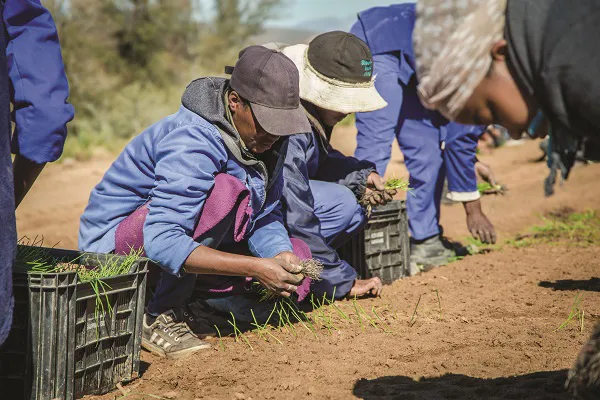 Plantlets are set out in wintertime (photos by Ilse Jordan)
Plantlets are set out in wintertime (photos by Ilse Jordan)
In July/August the seedlings are transplanted by hand out into open fields (creating many seasonal work opportunities) and by December the bulbs are harvested. The bulbs are dried for three months over the hottest part of the year, saving them water, and giving them the opportunity to inspect and select bulbs for quality and uniformity.
By the following March or April the bulbs have started sprouting and they are again planted out in the soil to continue their growth cycle to a reproductive stage. Onions flower from the end of September, through November, and into December. After pollination the plants are left in the field, ready to be harvested around Christmas and New Year.
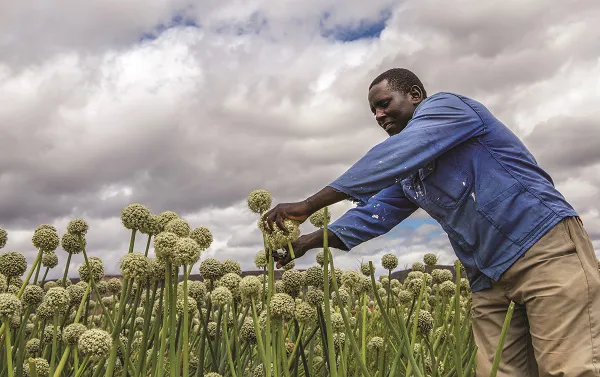 Onion flowerheads harvested in late summer
Onion flowerheads harvested in late summer
Flowerheads are cut by hand and dried until January/February, then harvested and delivered for cleaning to their seed cleaning factory. After quality control the seed is packed and shipped from April until June.
“It is very high-risk production and we can only use the very best producers for this,” he says. “It’s a very intensive industry with high rewards.”
Testing seed for viability and purity
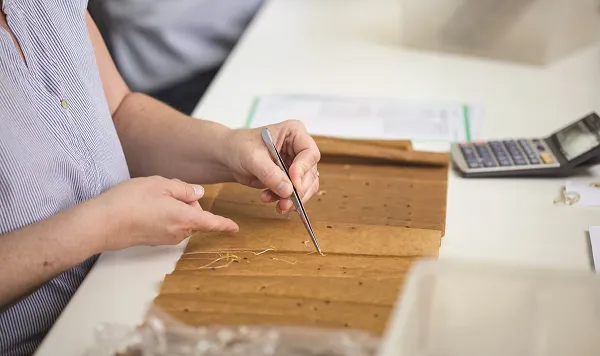 A minimum germination rate of 85% is required
A minimum germination rate of 85% is required
When seeds attain the minimum standards of a moisture level below 7.5%, germination rate higher than 85% and a purity 99.5% and higher, as determined at their inhouse International Seed Testing Association (ISTA)-accredited laboratory (one of eight in Africa of which five are in South Africa) they are packed into double layered bags, sealed to protect the hygroscopic seeds against moisture when crossing the equator. 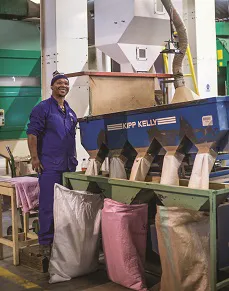 Increasingly, David remarks, their clients are asking for bigger bags instead of the traditional 20kg and 25kg bags due to labour shortages internationally.
Increasingly, David remarks, their clients are asking for bigger bags instead of the traditional 20kg and 25kg bags due to labour shortages internationally.
Right: bagging vegetable seed into double layered bags
Sometimes seed is flown out, otherwise it’s shipped out either on conventional vessels or on reefers.
Klein-Karoo Saad also remind shipping lines not to place the bags close to heat sources like boilers or in open sun.
Vegetable seed competes with citrus for containers
“The citrus industry has experienced big growth recently and we compete with them for available containers during March until June,” he says, remarking that fresh product gets priority.
“One can’t not mention the condition of our ports, which is a tremendous concern. This past season we increasingly made use of the ports of Coega and Port Elizabeth [renamed Gqeberha] as an alternative to Cape Town.”
The water situation looks better than during the past five years with recent rains but dams are still very empty – the Kammanassie Dam stands at 5% (totally dry a year ago), the Stompdrift Dam is at almost 18% and the Gamkapoort Dam is now 59% full.
“Water is still a concern – we hope farmers will be able to make use of irrigation water from dams again. For the past four or five years they’ve been wholly dependent on runoff from the mountains, underground sources and fountains. The Klein-Karoo gets at most 220mm of rain a year, so dryland seed production is impossible.”
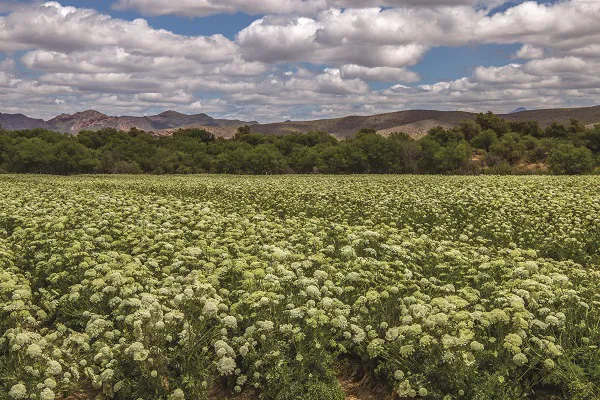 A flowering field of carrots grown for seed by Klein-Karoo Seed Production
A flowering field of carrots grown for seed by Klein-Karoo Seed Production
Seed companies are a central pillar to food security
Klein Karoo Seed Production continues to investigate new crops and seed types for local seed production but is also investigating new areas in which seed can be produced successfully.
“Developing new commercial and subsistence growers and successfully transferring technology to them, is a core activity to ensure sustainable growth and expansion for the company and the industry,” he says.
“As an independent seed producer, Klein Karoo Seed Production fulfills a crucial role in supply chain management for big and small seed companies around the world, which, as such, form a central pillar in the food chain and sustainable food security for all.”
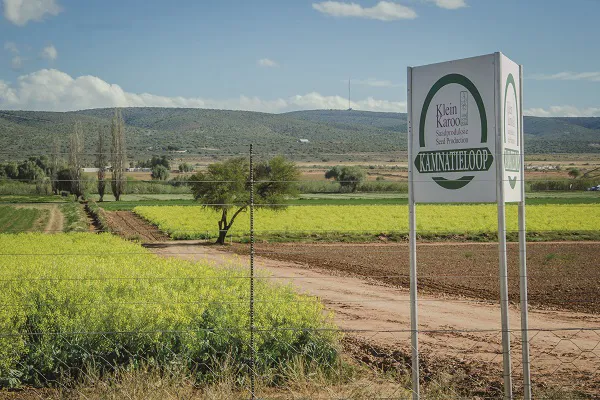 All photos by Ilse Jordan
All photos by Ilse Jordan
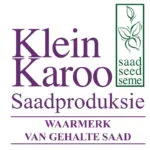 For more information:
For more information:
David Malan
Klein Karoo Seed Production
Tel: +27 44 203 5259
https://www.seedproduction.co.za/
